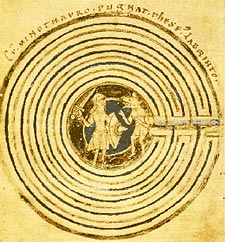The Classical Labyrinth
(also known as Cretan, Seven-path/circuit)
Existing for at least 3500 years, the archetypal labyrinth design consists of a single pathway that loops back and forth to form seven circuits, bounded by eight walls, surrounding the central goal. It is found in both circular and square forms. Practically all labyrinths prior to the first few centuries BCE are of this type. Found in historical contexts throughout Europe, North Africa, the Indian sub-continent and Indonesia, this is also the design that occurs in the American Southwest and occasionally in South America. During the current revival of labyrinths it has once again found popularity for its simplicity of construction and archetypal symbolism.
This form is also (inappropriately) known as the “Cretan” labyrinth, a term that implies an origin on the island of Crete. Although its subsequent association with the legendary Labyrinth at Knossos is well documented, the design certainly predates the legend and has not been found on Crete prior to the fourth century BCE. It is also known as the “seven-circuit labyrinth,” but this too is confusing, for other labyrinth types can have seven paths and classical labyrinths may have more, or less, than seven circuits. The term “Classical” has gained widespread acceptance in recent years and is to be preferred, as it correctly implies the original form and is free from association with any particular location or region — appropriate for a design that is found worldwide.
The simplicity of its construction from an easily remembered seed pattern has clearly been instrumental in the wide cultural dissemination of the classical labyrinth. It is by far the world’s most common form, and remains popular to this day. Simple amendments to the seed pattern allow different versions of this form to be created quickly and easily and such varieties, often with eleven or fifteen circuits, are common in historical contexts in northern Europe and especially in Scandinavia. Several important variants used in historical contexts are distinctive enough to deserve sub-categories of their own

Circular and square varieties of the classical labyrinth design. Mirror image forms will result in the first pathway turning either left or right. Both forms are common and may simply be a consequence of the handedness of the creator.
(also known as Baltic Wheel or Goddess)
Found throughout Scandinavia and also in northern Germany, but principally around the shorelines of the Baltic Sea, this labyrinth is also known as the “Baltic Wheel” or “Wheel,” after an important example in Hanover, Germany. A relatively simple reconnection of the upper part of the classical seed pattern produces a double spiral at the centre with separate entrance and exit paths. These labyrinths are ideal for continuous processions and games where two or more walkers enter the labyrinth, and this purpose is often reflected in associated traditions and folklore.

Baltic type labyrinth cut in turf at Dransfeld, Germany (now destroyed). The double spiral at the centre allows a quick exit from the centre of the labyrinth.
(also known as Hecate)
An unusual development of the classical labyrinth, found primarily in India, is based on a three-fold, rather than four-fold seed pattern and is often drawn with a spiral at the centre. It is referred to in Indian tradition as Chakra-vyuha, a name derived from a magical troop formation employed by the magician Drona at the battle of Kurukshetra, as recounted in the Mahabharata epic.

The stone labyrinth at Baire Gauni, near Chinnakottur in Tamil Nadu, India, is laid out in the Chakra-vyuha syle commonly encountered throughout India.
Other labyrinths based on three-fold and occasionally on two-fold or five-fold seed patterns are found in various locations. A unique five-fold classical labyrinth with nine circuits recently discovered on a Pima basket from Arizona demonstrates the many varieties of labyrinth that can be created with a full understanding of the construction process. A number of labyrinths with curious designs, obviously based on the classical form, or incorrectly drawn by unskilled hands, should also be included in this category.

A Pima hand-woven basket, made early 20th century, with an unusual nine-path variant of the classical design created from a five-fold seed pattern.

The Otfrid labyrinth design, here the scene for the battle between Theseus and the Minotaur, in a late twelfth century manuscript from Regensburg, Germany.
© 2004-2024 The Labyrinth Society & Veriditas. All Rights Reserved.